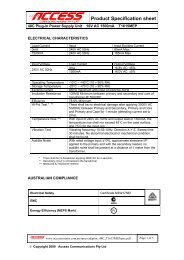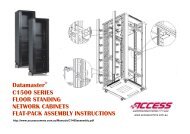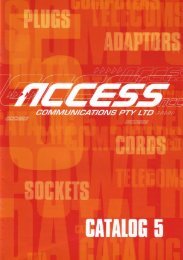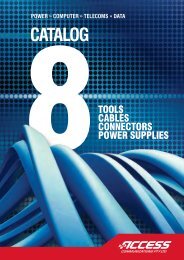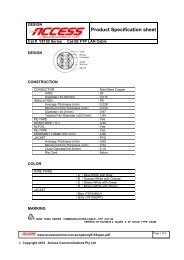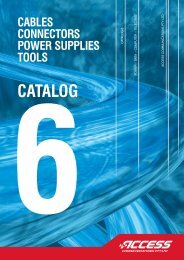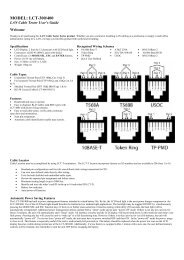Power computer telecoms data - Access Communications
Power computer telecoms data - Access Communications
Power computer telecoms data - Access Communications
Create successful ePaper yourself
Turn your PDF publications into a flip-book with our unique Google optimized e-Paper software.
Reference<br />
Approvals, Permits and Compliance<br />
ACA / Austel Compliance<br />
The Australian Telecommunications Authority (Austel) were responsible for<br />
issuing cabling licences, equipment permits and monitoring the conduct of<br />
licence and permit holders for all equipment and components connected to<br />
the Australian telephone network. The Spectrum Management Agency (SMA)<br />
was the Australian Commonwealth statutory agency responsible for the<br />
management of radio-communications in Australia. On 1 July 1997, AUSTEL<br />
and SMA merged to form the Australian <strong>Communications</strong> Authority (ACA).<br />
The ACA is now responsible for technical regulation, consumer issues and<br />
licensing of telecommunications and radio-communications in Australia.<br />
A-Tick<br />
The A-tick and ACA supplier code indicates compliance<br />
with Australian telecommunications requirements and<br />
that the equipment can be legally connected to the<br />
Australian telecommunications network. Our ACA<br />
supplier code is N692.<br />
C-Tick<br />
C-Tick markings may also appear on products which<br />
are required to comply with Australian electromagnetic<br />
compatibility requirements and radio-communications<br />
standards and indicates that the product may be legally<br />
sold in Australia. Our ACA supplier code is N692<br />
Since 31 December 1998, all equipment which requires<br />
EMC compliance must be marked with the C-tick and<br />
ACA supplier code number. The supplier is responsible<br />
for holding a compliance folder which contains<br />
compliant test reports and a declaration of conformity.<br />
A-Cross<br />
If an item covered by the Telecommunications Labelling Notice does<br />
not comply with the applicable standard(s) and it is not a permitted<br />
item, it is regarded as non-compliant.<br />
All non-compliant items must be labelled with the A-Cross noncompliance<br />
symbol and the non-compliance notice shown below.<br />
CAUTION<br />
DO NOT USE BEFORE READING THE INSTRUCTIONS<br />
Do not connect this customer equipment or customer cabling to a carrier or<br />
carriage service provider’s telecommunications network or facility unless:<br />
(a) you have the written consent of the network or facility manager; or<br />
(b) the connection is in accordance with a connection permit or connection<br />
rules.<br />
Connection of this customer equipment or customer cabling may cause a<br />
hazard or damage to the telecommunications network or facility, or persons,<br />
with consequential liability for substantial compensation.<br />
N692<br />
N692<br />
3-pin Australian Mains Plug<br />
Use Marking Flex Conductor Colors<br />
Building Wire<br />
Conductor Colors<br />
Active A Brown Red<br />
Neutral N Blue Black<br />
Earth E Green/Yellow Green/Yellow<br />
<strong>Power</strong> Calculation<br />
The following formula is used to calculate wattage (or VA). This formula is useful<br />
to determine if a required voltage and current combination will exceed the<br />
maximum capacity of a particular AC Adaptor’s case.<br />
Volts x Amps = Watts (VA)<br />
Tip and Ring<br />
The names for the two wires of a telephone line were derived from the electrical<br />
contacts on the original 1/4 inch telephone plug. These plugs are similar in<br />
appearance to the 6.5mm diameter stereo phono plugs that are sometimes still<br />
used for stereo headsets. One electrical contact is at the tip of the plug (used for<br />
Line +) and the other is a ring just above it (used for Line -). There is also a third<br />
contact referred to as the sleeve.<br />
Electrical Safety<br />
Compliance & RCM<br />
<strong>Power</strong> cords and AC adaptors for use in Australia must<br />
be tested for compliance with state electrical safety<br />
authority regulations. The New South Wales state<br />
government department responsible for electrical safety<br />
is the Department of Fair Trading (DOFT). Most other<br />
states also have a department responsible for issuing<br />
Electrical Safety Certificates. A safety certificate issued<br />
in any state is recognised Australia wide. The product<br />
must be marked with a valid Electrical Safety Certificate<br />
Number e.g. N13816 or a RCM number issued by<br />
Standards Australia (SAA) e.g. N5071. C-Tick markings<br />
may also appear on an AC adaptor and show<br />
compliance with EMC standards. The RCM (Regulatory<br />
Compliance Mark) may be used as an alternative to<br />
show compliance with Electrical Safety and EMC<br />
standards. Our RCM (SAA) number is N5071.<br />
N5071<br />
DTMF - Dual Tone Multi Frequency<br />
DTMF is the signalling method used for dialling by most modern telephones.<br />
A pair of frequencies is assigned to each of 12 dial buttons on the telephone.<br />
<br />
used now. DTMF signalling is also sometimes referred to as Tone Dialling,<br />
VF Signalling, MF Dialing or Touch Tone. The “#” symbol is also known by many<br />
different names including Crosshatch, Hatch, Pound and Octothorpe.<br />
DTMF Frequency Matrix<br />
Low Group<br />
Frequencies<br />
High Group Frequencies<br />
Hz 1209 Hz 1336 Hz 1477 Hz 1633 Hz<br />
697 Hz 1 2 3 A<br />
770 Hz 4 5 6 B<br />
852 Hz 7 8 9 C<br />
941 Hz * 0 # D<br />
Web www.accesscomms.com.au » Email sales@accesscomms.com.au<br />
39



